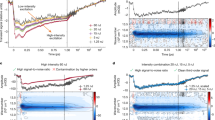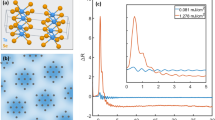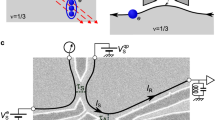Abstract
The concept of quasiparticles in solid-state physics is an extremely powerful tool for describing complex many-body phenomena in terms of single-particle excitations1. Introducing a simple particle, such as an electron, hole or phonon, deforms a many-body system through its interactions with other particles. In this way, the added particle is ‘dressed’ or ‘renormalized’ by a self-energy cloud that describes the response of the many-body system, so forming a new entity—the quasiparticle. Using ultrafast laser techniques, it is possible to impulsively generate bare particles and observe their subsequent dressing by the many-body interactions (that is, quasiparticle formation) on the time and energy scales governed by the Heisenberg uncertainty principle2. Here we describe the coherent response of silicon to excitation with a 10-femtosecond (10-14 s) laser pulse. The optical pulse interacts with the sample by way of the complex second-order nonlinear susceptibility to generate a force on the lattice driving coherent phonon excitation. Transforming the transient reflectivity signal into frequency–time space reveals interference effects leading to the coherent phonon generation and subsequent dressing of the phonon by electron–hole pair excitations.
This is a preview of subscription content, access via your institution
Access options
Subscribe to this journal
Receive 51 print issues and online access
$199.00 per year
only $3.90 per issue
Buy this article
- Purchase on Springer Link
- Instant access to full article PDF
Prices may be subject to local taxes which are calculated during checkout



Similar content being viewed by others
References
Pines, D. & Nozieres, P. Theory of Quantum Liquids (Benjamin, New York, 1966)
Huber, R. et al. How many-particle interactions develop after ultrafast excitation of an electron-hole plasma. Nature 414, 286–289 (2001)
Fischer, B. & Hofmann, K. R. A full-band Monte Carlo model for the temperature dependence of electron and hole transport in silicon. Appl. Phys. Lett. 76, 583–585 (2000)
Downer, M. C. & Shank, C. V. Ultrafast heating of silicon on sapphire by femtosecond optical pulses. Phys. Rev. Lett. 56, 761–764 (1986)
Sjodin, T., Petek, H. & Dai, H.-L. Ultrafast carrier dynamics in silicon: A two-color transient reflection grating study on a (111) surface. Phys. Rev. Lett. 81, 5664–5667 (1998)
Sabbah, A. J. & Riffe, D. M. Femtosecond pump-probe reflectivity study of silicon carrier dynamics. Phys. Rev. B 66, 165217 (2002)
Buhleier, R., Lüpke, G., Marowsky, G., Gogolak, Z. & Kuhl, J. Anisotropic interference of degenerate four-wave mixing in crystalline silicon. Phys. Rev. B 50, 2425–2431 (1994)
Bigot, J. Y., Portella, M. T., Schoenlein, R. W., Cunningham, J. E. & Shank, C. V. Two-dimensional carrier-carrier screening in a quantum well. Phys. Rev. Lett. 67, 636–639 (1991)
Goldman, J. R. & Prybyla, J. A. Ultrafast dynamics of laser-excited electron distribution in silicon. Phys. Rev. Lett. 72, 1364–1367 (1994)
Pfeifer, T., Dekorsky, T., Kütt, W. & Kurz, H. Generation mechanism for coherent LO phonons in surface-space-charge fields of III–V-compounds. Appl. Phys. A 55, 482–488 (1992)
Saeta, P. N., Greene, B. I. & Chuang, S. L. Short terahertz pulses from semiconductor surfaces: The importance of bulk difference-frequency mixing. Appl. Phys. Lett. 63, 3482–3484 (1993)
Johnston, M. B., Whittaker, D. M., Corchia, A., Davies, A. G. & Linfield, E. H. Simulation of terahertz generation at semiconductor surfaces. Phys. Rev. B 65, 165301 (2002)
Khurgin, J. B. Optical rectification and teraherz emission in semiconductors excited above the band gap. J. Opt. Soc. Am. B 11, 2492–2501 (1994)
Sipe, J. E., Mizrahi, V. & Stegeman, G. I. Fundamental difficulty in the use of second-harmonic generation as a strictly surface probe. Phys. Rev. B 35, 9091–9094 (1987)
Caumes, J.-P., Videau, L., Rouyer, C. & Freysz, E. Kerr-like nonlinearity induced via terahertz generation and the electro-optical effect in zinc blende crystals. Phys. Rev. Lett. 89, 047401 (2002)
Cerdeira, F., Fjeldly, T. A. & Cardona, M. Effect of free carriers on zone-center vibrational modes in heavily doped p-type Si II. Optical modes. Phys. Rev. B 8, 4734–4745 (1973)
Scholz, R., Pfeifer, T. & Kurz, H. Density-matrix theory of coherent phonon oscillations in germanium. Phys. Rev. B 47, 16229–16236 (1993)
Stevens, T. E., Kuhl, J. & Merlin, R. Coherent phonon generation and the two stimulated Raman tensors. Phys. Rev. B 65, 144304 (2002)
Lautenschlager, P., Garriga, M., Viña, L. & Cardona, M. Temperature dependence of the dielectric function and interband critical points in silicon. Phys. Rev. B 36, 4821–4830 (1987)
Cerdeira, F. & Cardona, M. Effect of carrier concentration on the Raman frequencies of Si and Ge. Phys. Rev. B 5, 1440–1454 (1972)
Contreras, G., Sood, A. K. & Cardona, M. Raman scattering by intervalley carrier-density fluctuations in n-type Si: Intervalley and intravalley mechanisms. Phys. Rev. B 32, 924–929 (1985)
Chandrasekhar, M., Rössler, U. & Cardona, M. Intra- and interband Raman scattering by free carriers in heavily doped p-Si. Phys. Rev. B 22, 761–770 (1980)
Wolff, P. A. Effect of nonparabolicity on light scattering from plasmas in solids. Phys. Rev. 171, 436–444 (1968)
Bairamov, B. H., Ipatova, I. P. & Voitenko, V. A. Raman scattering from current carriers in solids. Phys. Rep. 229, 221–290 (1993)
Kanehisa, M. A., Wallis, R. F. & Balkanski, M. Interband electronic Raman scattering in p-silicon. Phys. Rev. B 25, 7619–7625 (1982)
Belitsky, V. I., Cantarero, A., Cardona, M., Trallero-Giner, C. & Pavlov, S. T. Feynman diagrams and Fano interference in light scattering from doped semiconductors. J. Phys. Condens. Matter 9, 5965–5976 (1997)
Lautenschlager, P., Allen, P. B. & Cardona, M. Phonon-induced lifetime broadenings of electronic states and critical points in Si and Ge. Phys. Rev. B 33, 5501–5511 (1986)
Fano, U. Effects of configuration interaction on intensities and phase shifts. Phys. Rev. 124, 1866–1878 (1961)
Balkanski, M., Jain, K. P., Beserman, R. & Jouanne, M. Theory of interference distortion of Raman scattering line shapes in semiconductors. Phys. Rev. B 12, 4328–4337 (1975)
Acknowledgements
We thank D. Boyanovsky, A. P. Heberle, K. Ishioka and J. Shan for discussions. This work was supported by the NSF, the University of Pittsburgh, a Grant-in-Aid for Scientific Research from MEXT of Japan, and NIMS Research Funds.
Author information
Authors and Affiliations
Corresponding author
Ethics declarations
Competing interests
The authors declare that they have no competing financial interests.
Rights and permissions
About this article
Cite this article
Hase, M., Kitajima, M., Constantinescu, A. et al. The birth of a quasiparticle in silicon observed in time–frequency space. Nature 426, 51–54 (2003). https://doi.org/10.1038/nature02044
Received:
Accepted:
Issue Date:
DOI: https://doi.org/10.1038/nature02044
This article is cited by
-
Dynamic optical response of solids following 1-fs-scale photoinjection
Nature (2023)
-
Neural network interatomic potential for laser-excited materials
Communications Materials (2023)
-
Complex energies of the coherent longitudinal optical phonon–plasmon coupled mode according to dynamic mode decomposition analysis
Scientific Reports (2021)
-
Nonlinear charge oscillation driven by a single-cycle light field in an organic superconductor
Nature Photonics (2018)
-
A cascading nonlinear magneto-optical effect in topological insulators
Scientific Reports (2018)
Comments
By submitting a comment you agree to abide by our Terms and Community Guidelines. If you find something abusive or that does not comply with our terms or guidelines please flag it as inappropriate.



